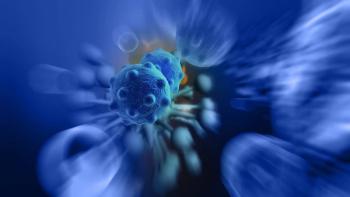
Ultra-Hypofractionated Radiation May Mitigate Breast Cancer Recurrence
Ultra-hypofractionated radiation in those 65 years or older with early breast cancer yielded no ipsilateral recurrence after a 10-month follow-up.
CancerNetwork® spoke with Bin Gui, MD, a fourth-year radiation oncology resident at the Northwell Health Cancer Institute, about the efficacy of ultra-hypofractionated radiation (UHFRT) among older patients with early-stage breast cancer presented at the
Gui briefly explained the methodology employed when conducting the study assessing UHFRT in this population. Patients were treated using regimens employed in the phase 3 FAST-Forward trial (ISRCTN19906132) and an accelerated partial breast irradiation (APBI) trial (NCT02104895).2,3
He further stated that there was compliance among all patients assigned to radiotherapy vs those assigned to radiation plus endocrine therapy, in which only 24% complied partly due to adverse effects. He described how low-grade or late toxicities occurred infrequently in patients undergoing radiation with or without endocrine therapy.
Results from the trial presented at ASTRO found that at a 10-month follow-up, no ipsilateral breast tumor recurrence (IBTR) occurred in the UHFRT cohort. Furthermore, there was an absence of grade 3 or 4 toxicities, and minimal low-grade (UHFRT alone, 2%; UHFRT plus ET; 0%) and late (2% vs 0%) toxicities were observed with radiation therapy.
Transcript:
Over 1000 [patients] with early-stage breast cancer were treated in our center back within the [past] 4 years. Seventy-one [patients] met the low-risk inclusion criteria and were treated with either whole breast FAST-Forward regimens or accelerated partial breast irradiation [APBI] regimens. What did we find here? The median tumor size was 0.8 cm. [Although] the compliance with radiation was 100%, the compliance with the endocrine therapy was only 24% either due to refusal or termination of endocrine therapy due to [adverse] effects. We have a median follow-up of 10 months, and there was no local recurrence in the entire cohort, and there was no grade 3 or 4 toxicity. The grade 2 acute toxicity, late toxicity, and cosmetic outcomes were [all] low for radiation plus endocrine therapy, or radiation alone.
References
- Gui B, Ojo O, Ottensoser L, et al. Ultra-Hypofractionated Radiation in Older Patients with Low Risk Early-Stage Breast Cancer. Presented at the 2024 American Society for Radiation Oncology (ASTRO) Annual Meeting; September 29 – October 2, 2024; Washington, DC. Poster 2683
- Brunt AM, Haviland JS, Wheatley DA, et al. One versus three weeks hypofractionated whole breast radiotherapy for early breast cancer treatment: the FAST-Forward phase III RCT. Health Technol Assess 2023;27(25). doi:10.3310/WWBF1044
- Meattini I, Marrazzo L, Saieva C, et al. Accelerated partial-breast irradiation compared with whole-breast irradiation for early breast cancer: long-term results of the randomized phase III APBI-IMRT-Florence trial. J Clin Oncol. 2020;38(35):4175-4183. doi:10.1200/JCO.20.00650.
Newsletter
Stay up to date on recent advances in the multidisciplinary approach to cancer.





















































































